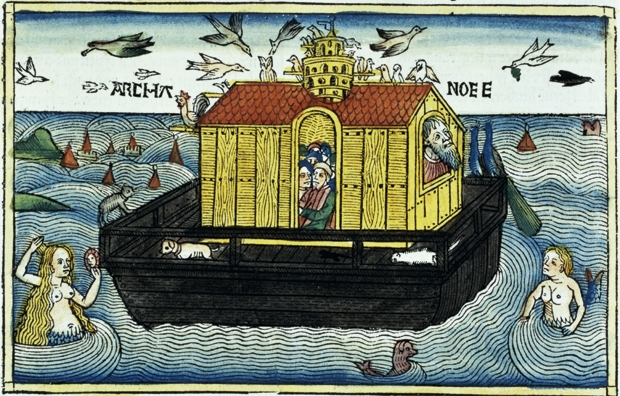This is a book about the clash of faith and reason over the truth or otherwise of a catastrophic, world-shaping flood — and it doesn’t once mention climate change. The debate here is much less stale.
David Montgomery is a prize-winning geology professor at the University of Washington, Seattle, and he recounts the history of his discipline from Aristotle to plate tectonics, showing how geological thinking has always been shaped by the great narrative of Noah’s flood. It is a grand tale, and told with verve and excitement. Montgomery also entertainingly surveys the archaeological and literary evidence for ancient Middle Eastern floods — each of which has been acclaimed, in turn, as ‘Noah’s’.
The major theological puzzle wasn’t that Genesis described the deluge as having lasted both 40 and 150 days. The big debate was whether the flood was a local or global affair. Translation hadn’t helped. St Jerome rendered the Hebrew eretz, meaning ‘land’ or ‘soil’, as terra — which was in turn translated into English as ‘earth’. This suggested to many that the flood affected the whole planet, and that rivers, mountains and continents were formed by the flood —and not at creation.
Then there were the fossils, which were plainly everywhere. One of the first to doubt that they were evidence of a global deluge, interestingly, was Leonardo. Investigating a cave in the hills near Vinci, he found the rock to be ‘a hash of seashells and fish bones’. Yet, having tested sediment in water, he knew that heavy objects settled; they were not distributed evenly. And spotting worm tracks in the stone, he wondered how such creatures should have crawled around serenely during an epic global flood.
As others started to look at the rocks around them with Leonardo-like attentiveness, extravagant flood theories accumulated. Descartes concluded that a cooling earth crusted over an underground ocean that, heated to steam by the sun, eventually cracked its carapace and catastrophically burst out, creating both mountains and sea.
Edward Stillingfleet, Bishop of Worcester, calculated in 1666 that all the clouds in the world could produce a foot and a half of water at most. Two years after his comet returned, in 1682, Edmund Halley invoked it in a new theory that the comet shock shook the world’s axis, sending the oceans ‘sloshing back and forth across the continents’, and causing an immense vapour canopy to collapse. That answered Stillingfleet.
The Cambridge theologian Thomas Burnet preferred a subterranean source for the flood, though his theory also required native Americans to be descendants of Adam who had walked to the New World before the Flood divided them from their European cousins. Herbert Croft, Bishop of Hereford, wondered if Burnet’s brain was ‘crakt with over-love of his own invention’.
Montgomery listens with more respect. To his credit, he does not trace a triumphalist line leading from natural philosophy to science. He listens to theology as much as geology. He notes the dispute between Luther and Calvin, for instance. The latter could not agree that a flood might raise up mountains, nor that mountains could be cursed by God, and his followers attempted to accommodate scientific inquiry in their belief. Lutherans tended more to literalistic interpretations of scripture.
This division between faith that adapts itself to reason and religion that rejects it, is at the heart of the book. Montgomery spends his last chapters rebutting American creationists, who hark back to Bishop Ussher’s 1650 calculation of the earth’s age. Ussher totted up the likely ages of all those begats, matched them to what was then known of ancient history, and came up with a creation date of 4004 BC. This made it into a marginal note in the King James Bible.
To match the world to Ussher, modern creationists rehash all the extravagant theories of the past in happy ignorance of their thorough scientific refutation. They must also bend or ignore all the corroborative science that has been done since 1650: no tree rings, ice cores, plate tectonics or radiocarbon dating. There is an entertaining chapter on the ‘mammoth problem’: mammoth corpses plainly show that they did not die in floods.
Montgomery rightly analyses creationism as a political and social phenomenon. He traces its roots to uneducated charismatic preachers in the 19th century, who were weaned on plain-sense, populist Protestantism, where one man’s interpretation was as good as the next — and where a literally read Bible was the only higher authority.
And so the idea of a global flood, which had been ‘laughed out of Victorian England’, as Montgomery puts it, ‘took root in Cold War America’. Modern creationists saw geology, as they saw evolution, as the creature of a modernism that was inextricably linked to communism. Scientists were distrusted as dangerous, elitist liberals.
Which takes us back to climate change. Montgomery doesn’t raise it, as I mentioned, but you can guess where he stands: with the scientists. Except that he tells one curious story. In the 1920s, the geologist J. Harlen Bretz uncovered evidence of a catastrophic giant flood in eastern Washington. He was derided as a heretic before the evidence slowly mounted up. Now, once again, scientists accept that catastrophic flooding can shape the world.






Comments